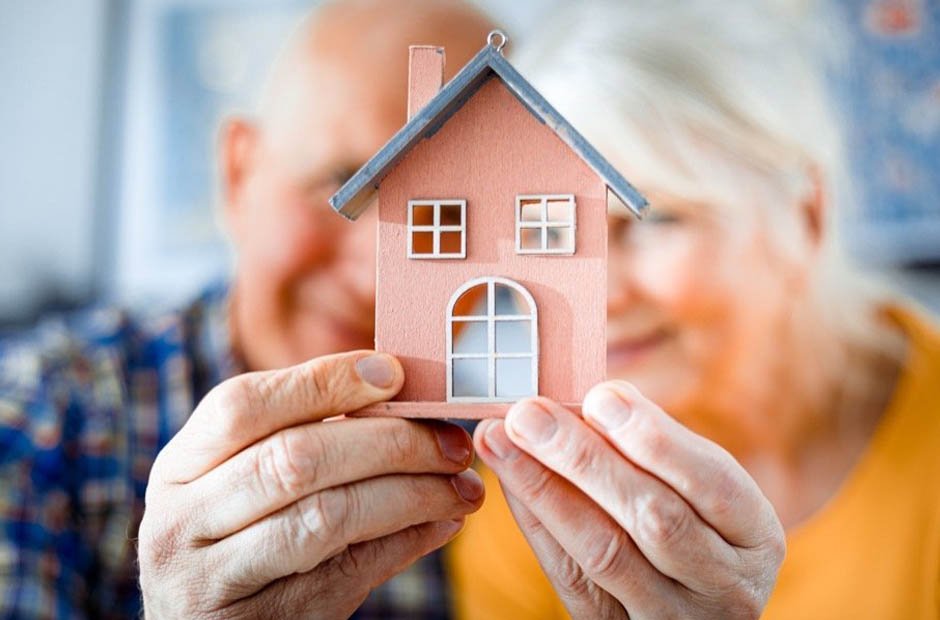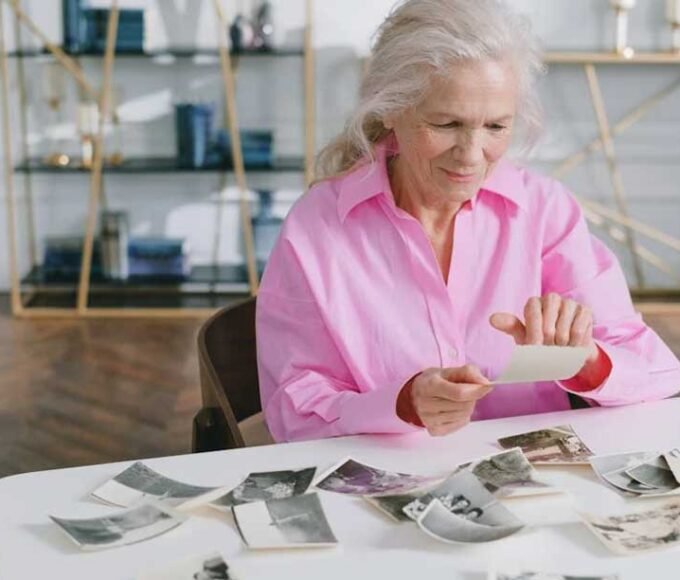Aging in place means seniors can keep living in their homes and communities as they age. Many older people want this because they like their freedom and being in a place they know well.
But it can be challenging. Growing older can make walking, balancing, and doing regular stuff harder, leading to accidents and injuries. Seniors might also feel lonely and cut off from others because they lose friends and can’t get around easily.
Money can also be a problem because not everyone can afford to make their home safer and more comfortable.
That’s where color experts come in. They can pick the right colors for a home to make it safe and cozy for seniors.
These colors help with seeing well, preventing falls, and making the home feel welcoming.
Even though there are challenges, having the help of color experts can make aging in place better for seniors by creating homes that are safe and comfy.
The Role of Color in Home Design
Colors in a home can change how you feel and can be very important for seniors. Some colors, like red, orange, and yellow, can make you feel energetic and happy.
These colors can make a home feel warm and cozy, which helps fight loneliness and sadness.
Other colors, like blue, green, and purple, are calming and soothing. They can make a home feel peaceful, which can help seniors who feel stressed or anxious.
These colors can also help seniors sleep better, which is important for their health.
When choosing colors for seniors’ homes, it’s crucial to consider what they need and like.
Some seniors may have trouble seeing or remembering things, so it’s good to pick colors that are very different. For example, using different colors for walls and furniture can help seniors see things better and avoid accidents.
Ultimately, the colors in a home can make a big difference for seniors. Color experts can choose the right colors to make seniors feel happy, relaxed, and safe.
By thinking about what each senior needs, color consultants can make homes look great and also help seniors feel better in many ways.
Benefits of Residential Color Consulting
1. Safer Homes:
- Color experts know which colors help seniors see better and reduce the chance of falling.
- They suggest colors with substantial differences that make it easy for seniors to move around, especially if they have trouble with their eyes or memory.
- Using these different colors for walls, furniture, and important things like handrails makes homes safer and lets seniors be more independent.
2. Easier to Get Around:
- Color experts understand how to make homes simple for seniors who can’t move as easily.
- They pick colors that show where important places like doorways and stairs are, helping seniors find their way.
- By using color carefully in these areas, seniors can find different parts of their homes easily, which makes them more independent and less frustrated.
3. More Comfort:
- Color experts know that colors can change how people feel.
- They choose colors that make a home feel warm and nice, which helps seniors be happier and more relaxed.
- Colors like red, orange, and yellow add energy and coziness, making homes feel welcoming and fighting sadness or loneliness.
- Colors like blue, green, and purple make homes calm and reduce stress.
- By thinking about what each senior needs, color experts make homes that look good and also help seniors feel better.
Getting help from color experts for senior-friendly homes has many benefits. They make homes safer, easier to move around in, and more comfortable. This helps seniors stay independent and feel better as they get older.
Choosing Safe and Comfortable Color Palettes
1: Safe and Clear
For senior-friendly homes, it’s important to pick colors that stand out, like pairing light walls with dark furniture. These high-contrast color combinations make it easier to see things, lowering the chances of accidents and falls. This is especially helpful for seniors with vision problems or memory issues. Bright colors can help them spot important things like handrails and doorways, which keeps them safe and independent.
2: Warm and Happy Colors
Colors like red, orange, and yellow bring warmth and happiness to a home. They create a cozy and inviting atmosphere, which fights feelings of loneliness and sadness that seniors might experience alone. On the other hand, cool colors like blue, green, and purple have a calming effect. They help seniors relax and can lower stress, making it easier to sleep better, which is super important for their health.
3: Finding the Balance
To make a comfortable home, you need to use a mix of warm and cool colors. Warm colors in shared spaces like the living room create a friendly and social atmosphere. On the other hand, using cool colors in private areas like the bedroom helps seniors unwind and get good sleep, creating the perfect balance for senior-friendly homes.
In Summary:
Picking the right colors to improve safety and create a cozy atmosphere is key for designing great homes for seniors. These colors not only make the home look nice but also help seniors feel good and stay safe as they grow older in their place.
Color Consulting Process
The process of residential color consulting involves several vital steps to make sure the chosen colors meet the homeowners’ needs. Professionals work closely with the homeowners throughout the process to understand what they want.
Step 1: Initial Meeting
The first step is an initial meeting where the color consultant visits the home and talks with the homeowners about their goals and ideas. They also check out the existing design and style of the home. This meeting sets the foundation for the project.
Step 2: Space Assessment
After the initial meeting, the color consultant assesses the space. They consider things like how much light there is, the room size, and the layout. These factors help the color consultant decide on the best colors for each area.
Step 3: Color Palette
Next, the color consultant creates a color palette for the homeowners. This palette includes a range of colors that match the homeowners’ style. The consultant also explains how each color can affect the home’s mood. Homeowners can give feedback and make changes.
Step 4: Implementation Plan
Once the colors are chosen, the consultant makes a detailed plan for using them in each room. They recommend the right paint brands and finishes for the job.
Step 5: Ongoing Support
During the implementation, the color consultant stays in touch with the homeowners. They answer questions and visit the property to check that the colors are correctly used.
In conclusion, residential color consulting is a step-by-step process that involves close collaboration with homeowners. This ensures the chosen colors not only look good but also create a home environment that supports the residents’ well-being.
Real-Life Success Stories
Let’s talk about Mr. and Mrs. Johnson, a retired couple in their 70s. They wanted to make their home safer and more comfortable for their age. They brought in a color expert to help. The expert looked at their home and suggested some color changes to make things better.
First, they used high-contrast colors. Light walls and dark furniture made it easier to see things. This helped Mr. and Mrs. Johnson avoid tripping or bumping into stuff. They could move around without worries.
The color expert also used warm colors like red and orange in the living and dining areas. These colors made the rooms look nice and created a happy and social atmosphere. It boosted the couple’s mood and happiness.
For the bedroom, they used cool colors like blue and green. These colors were calming, especially for Mrs. Johnson, who often felt anxious and had trouble sleeping. The new colors helped her feel more relaxed and sleep better.
The changes also helped Mr. Johnson, who had mobility problems. The color expert used colors to highlight important areas like doors and stairs. This made it easier for him to find his way around. He felt more independent and less frustrated.
In the end, the color consulting made Mr. and Mrs. Johnson’s life better. High-contrast designs and warm and cool colors created a safe and comfy home. They could move around easily, felt happier, and slept better. It’s a great example of how color consulting can transform homes for seniors.
Practical Considerations
Picking the right colors for each part of your home is essential. Bathrooms need clean and refreshing colors like white or light blue to feel bright and clean.
In kitchens, you want vibrant and lively colors like red or orange to create an energetic atmosphere. You can also add some balance with cool colors like blue or green in your kitchen items.
Living spaces are where colors can set the mood. Neutral colors like beige or gray are calm and work well with any furniture. But if you want a lively atmosphere, try bold colors like deep red or rich purple on an accent wall or furniture piece.
Light is another crucial aspect to consider in your smart grind for selecting the right colors. Natural light from windows can significantly impact how colors appear within a space.
In rooms that lack sufficient natural light, embarking on a smart grind by opting for lighter colors is the key to making the room brighter and more inviting.
These lighter shades will work in your favor, creating a sense of openness and airiness even in spaces with limited natural light.
Your smart grind in choosing colors should align with the available light to make the most of your living areas.
But if you have lots of natural light, you can use darker colors without it feeling too dark.
Using different colors in your home can look nice, but it’s essential to create a balance. You can use complementary colors (colors opposite on the color wheel), like blue and orange for an exciting look.
Or use analogous colors (colors next to each other on the wheel), like blue and green, for a calming atmosphere. These choices help make your home feel just right for you.
Ultimately, choosing the right colors for different areas of your home is important. It makes your home look great and feel right for you. It’s all about making each space work well for what you want to do there.
Budget-Friendly Solutions
1: Affordable Color Updates
When changing the colors in your home without spending too much, there are budget-friendly options to consider. One of the simplest and most affordable ways is to repaint the walls. A fresh coat of paint can give a room a new look and atmosphere without breaking the bank. By choosing a color scheme that matches your existing furniture and decor, you can achieve a significant transformation without costly renovations.
2: Small Changes, Big Impact
You can also make a noticeable difference by focusing on smaller details. Changing items like doorknobs, drawer pulls, or light switch plates can introduce color and update the overall appearance of a space. These minor updates can be done on a budget and have a substantial impact on a room’s look and feel.
3: Using Color Through Accessories
If you want to add color without extensive remodeling, consider using colorful accessories like throw pillows, curtains, or rugs. These items can instantly brighten a room and add personality without a price tag. You can often find affordable options, making it easier to achieve your desired look without overspending. Accessories and accents offer an easy and cost-effective way to bring color into your space and experiment with different styles.
4: Smart Color Choices
For budget-friendly color updates, consider using neutral or lighter shades. These versatile colors can easily match your furniture and decor, saving you from costly replacements. Neutral colors create a calming and timeless backdrop that allows for future updates. They serve as a versatile canvas that can be transformed with pops of color through accessories and accents as your preferences evolve.
5: Repurposing for Savings
Another way to make impactful color changes without breaking the bank is by repurposing or upcycling existing furniture or decor. A fresh coat of paint can breathe new life into old items, giving them a new look and style.
This not only offers customization but also helps you avoid the expense of buying new items.
Repurposing furniture is both budget-friendly and environmentally friendly, allowing you to create a unique and personalized style for your home.
With these cost-effective tips, you can make significant color updates in your home while keeping your budget in check.
It’s all about being creative and resourceful finding affordable ways to refresh your living space. With imagination and a do-it-yourself approach, you can transform your home without breaking the bank.
Hiring a Residential Color Consultant
Selecting the perfect color consultant for your home involves considering several key factors. First, look for a consultant with a solid background in color theory and interior design or related fields.
This expertise ensures they can guide you effectively in choosing the right colors for your space. Additionally, find a consultant experienced in working with seniors, as aging in place has unique requirements, such as safety considerations and mobility challenges.
Ask for recommendations from friends or search for online reviews to gauge a consultant’s reputation. Arrange consultations with potential consultants to assess their experience, approach, and communication skills.
It’s important to choose someone who fits your budget and schedule, but remember that expertise and understanding of senior-friendly design are equally crucial.
By considering these elements, you can select the correct color consultant to create a safe, appealing home for aging in place.
Conclusion
Residential color consulting is vital for creating safe, comfortable, and visually appealing homes for seniors.
As we age, our needs change, and the right color choices can significantly impact our well-being and safety. Color consultants help enhance visibility, reduce risks, and create a soothing atmosphere.
They also add aesthetics and personal style to living spaces. Their expertise streamlines the decision-making process, saving homeowners time and effort.
So, whether planning a major renovation or a simple color refresh, a color consultant can make your home truly senior-friendly.
















